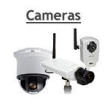|
General
This page allows you to configure most of the general i-catcher settings.
General
- Working path: This is the base path for the video and images that i-Catcher saves.
- Still image quality: Specifies the image quality used when saving JPeg files. 100 is the highest quality value, but also the largest.
- Monitor feed: This allows you to save a continually updating image either locally or to a network server.
- Update rate: This is the time i-Catcher waits before loading the next image frame, by default this is set to 200 ms. Changing this to a smaller value will make i-Catcher run faster, but use more system resources.
- Wait before monitoring: The period i-Catcher waits before starting can be set using this option. i-Catcher will not record any images or send any alerts during this period.
- Minimise to system tray: An icon will appear in the system tray whenever i-Catcher is minimised.
- Save zoomed images: will cause i-Catcher to save the zoomed image if either of the video windows are zoomed. If this is off, the images are saved at their native size.
Startup
- Start this profile when windows starts: will add a shortcut to your startup group to start i-Catcher using the current profile.
- Automatically start monitoring: will start i-Catcher monitoring when this profile loads. This option is disabled when scheduling is enabled.
- Automatically minimise: will minimise i-Catcher to the system tray or the task bar when the profile is loaded.
|

